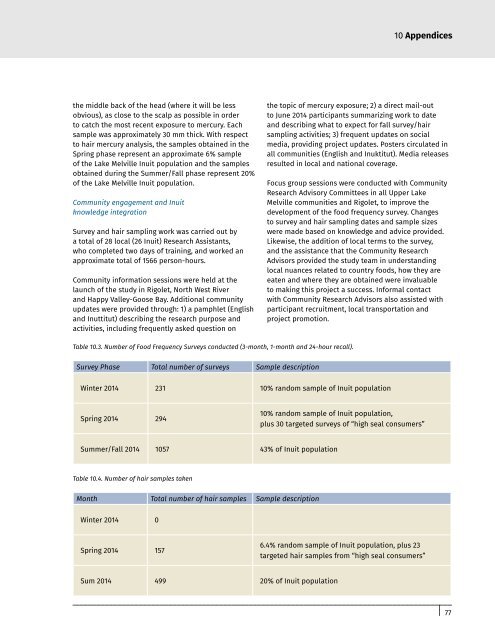Lake Melville
1rw7Mns
1rw7Mns
You also want an ePaper? Increase the reach of your titles
YUMPU automatically turns print PDFs into web optimized ePapers that Google loves.
10 Appendices<br />
the middle back of the head (where it will be less<br />
obvious), as close to the scalp as possible in order<br />
to catch the most recent exposure to mercury. Each<br />
sample was approximately 30 mm thick. With respect<br />
to hair mercury analysis, the samples obtained in the<br />
Spring phase represent an approximate 6% sample<br />
of the <strong>Lake</strong> <strong>Melville</strong> Inuit population and the samples<br />
obtained during the Summer/Fall phase represent 20%<br />
of the <strong>Lake</strong> <strong>Melville</strong> Inuit population.<br />
Community engagement and Inuit<br />
knowledge integration<br />
Survey and hair sampling work was carried out by<br />
a total of 28 local (26 Inuit) Research Assistants,<br />
who completed two days of training, and worked an<br />
approximate total of 1566 person-hours.<br />
Community information sessions were held at the<br />
launch of the study in Rigolet, North West River<br />
and Happy Valley-Goose Bay. Additional community<br />
updates were provided through: 1) a pamphlet (English<br />
and Inuttitut) describing the research purpose and<br />
activities, including frequently asked question on<br />
the topic of mercury exposure; 2) a direct mail-out<br />
to June 2014 participants summarizing work to date<br />
and describing what to expect for fall survey/hair<br />
sampling activities; 3) frequent updates on social<br />
media, providing project updates. Posters circulated in<br />
all communities (English and Inuktitut). Media releases<br />
resulted in local and national coverage.<br />
Focus group sessions were conducted with Community<br />
Research Advisory Committees in all Upper <strong>Lake</strong><br />
<strong>Melville</strong> communities and Rigolet, to improve the<br />
development of the food frequency survey. Changes<br />
to survey and hair sampling dates and sample sizes<br />
were made based on knowledge and advice provided.<br />
Likewise, the addition of local terms to the survey,<br />
and the assistance that the Community Research<br />
Advisors provided the study team in understanding<br />
local nuances related to country foods, how they are<br />
eaten and where they are obtained were invaluable<br />
to making this project a success. Informal contact<br />
with Community Research Advisors also assisted with<br />
participant recruitment, local transportation and<br />
project promotion.<br />
Table 10.3. Number of Food Frequency Surveys conducted (3-month, 1-month and 24-hour recall).<br />
Survey Phase Total number of surveys Sample description<br />
Winter 2014 231 10% random sample of Inuit population<br />
Spring 2014 294<br />
10% random sample of Inuit population,<br />
plus 30 targeted surveys of “high seal consumers”<br />
Summer/Fall 2014 1057 43% of Inuit population<br />
Table 10.4. Number of hair samples taken<br />
Month Total number of hair samples Sample description<br />
Winter 2014 0<br />
Spring 2014 157<br />
6.4% random sample of Inuit population, plus 23<br />
targeted hair samples from “high seal consumers”<br />
Sum 2014 499 20% of Inuit population<br />
77


